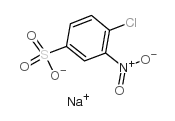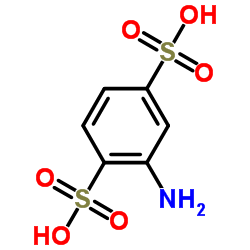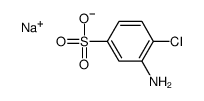Sodium 4-chloro-3-nitrobenzenesulfonate
Modify Date: 2025-08-24 18:27:20

Sodium 4-chloro-3-nitrobenzenesulfonate structure
|
Common Name | Sodium 4-chloro-3-nitrobenzenesulfonate | ||
|---|---|---|---|---|
| CAS Number | 17691-19-9 | Molecular Weight | 259.59900 | |
| Density | N/A | Boiling Point | N/A | |
| Molecular Formula | C6H3ClNNaO5S | Melting Point | 204-208 °C(lit.) | |
| MSDS | Chinese USA | Flash Point | N/A | |
| Symbol |

GHS07 |
Signal Word | Warning | |
| Name | sodium,4-chloro-3-nitrobenzenesulfonate |
|---|---|
| Synonym | More Synonyms |
| Melting Point | 204-208 °C(lit.) |
|---|---|
| Molecular Formula | C6H3ClNNaO5S |
| Molecular Weight | 259.59900 |
| Exact Mass | 258.93200 |
| PSA | 111.40000 |
| LogP | 2.75630 |
Synonym:Benzenesulfonic acid, 4-chloro-3-nitro-, sodium salt; Sodium 4-chloro-3-nitrobenzenesulphonat Section 2 - COMPOSITION, INFORMATION ON INGREDIENTS
Risk Phrases: 36/37/38 Section 3 - HAZARDS IDENTIFICATION EMERGENCY OVERVIEW
Irritating to eyes, respiratory system and skin. Potential Health Effects Eye: Causes eye irritation. May cause chemical conjunctivitis. Skin: Causes skin irritation. Ingestion: May cause gastrointestinal irritation with nausea, vomiting and diarrhea. Inhalation: Causes respiratory tract irritation. Can produce delayed pulmonary edema. Chronic: Effects may be delayed. Section 4 - FIRST AID MEASURES Eyes: Immediately flush eyes with plenty of water for at least 15 minutes, occasionally lifting the upper and lower eyelids. Get medical aid. Skin: Get medical aid. Flush skin with plenty of water for at least 15 minutes while removing contaminated clothing and shoes. Wash clothing before reuse. Ingestion: Never give anything by mouth to an unconscious person. Get medical aid. Do NOT induce vomiting. If conscious and alert, rinse mouth and drink 2-4 cupfuls of milk or water. Inhalation: Remove from exposure and move to fresh air immediately. If not breathing, give artificial respiration. If breathing is difficult, give oxygen. Get medical aid. Notes to Physician: Treat symptomatically and supportively. Section 5 - FIRE FIGHTING MEASURES General Information: As in any fire, wear a self-contained breathing apparatus in pressure-demand, MSHA/NIOSH (approved or equivalent), and full protective gear. During a fire, irritating and highly toxic gases may be generated by thermal decomposition or combustion. Extinguishing Media: Use water spray, dry chemical, carbon dioxide, or appropriate foam. Section 6 - ACCIDENTAL RELEASE MEASURES General Information: Use proper personal protective equipment as indicated in Section 8. Spills/Leaks: Sweep up, then place into a suitable container for disposal. Provide ventilation. Section 7 - HANDLING and STORAGE Handling: Wash thoroughly after handling. Remove contaminated clothing and wash before reuse. Avoid contact with eyes, skin, and clothing. Keep container tightly closed. Avoid ingestion and inhalation. Use with adequate ventilation. Wash clothing before reuse. Storage: Store in a tightly closed container. Store in a cool, dry, well-ventilated area away from incompatible substances. Section 8 - EXPOSURE CONTROLS, PERSONAL PROTECTION Engineering Controls: Facilities storing or utilizing this material should be equipped with an eyewash facility and a safety shower. Use adequate ventilation to keep airborne concentrations low. Exposure Limits CAS# 17691-19-9: Personal Protective Equipment Eyes: Wear appropriate protective eyeglasses or chemical safety goggles as described by OSHA's eye and face protection regulations in 29 CFR 1910.133 or European Standard EN166. Skin: Wear appropriate protective gloves to prevent skin exposure. Clothing: Wear appropriate protective clothing to prevent skin exposure. Respirators: A respiratory protection program that meets OSHA's 29 CFR 1910.134 and ANSI Z88.2 requirements or European Standard EN 149 must be followed whenever workplace conditions warrant respirator use. Section 9 - PHYSICAL AND CHEMICAL PROPERTIES Physical State: Powder Color: pale yellow Odor: None reported. pH: Not available. Vapor Pressure: Not available. Viscosity: Not available. Boiling Point: Not available. Freezing/Melting Point: Not available. Autoignition Temperature: Not applicable. Flash Point: Not applicable. Explosion Limits, lower: Not available. Explosion Limits, upper: Not available. Decomposition Temperature: Not available. Solubility in water: Not available. Specific Gravity/Density: Not available. Molecular Formula: C6H3ClNO5SNa Molecular Weight: 259.59 Section 10 - STABILITY AND REACTIVITY Chemical Stability: Stable at room temperature in closed containers under normal storage and handling conditions. Conditions to Avoid: Incompatible materials, excess heat, strong oxidants. Incompatibilities with Other Materials: Strong oxidizing agents, strong bases. Hazardous Decomposition Products: Hydrogen chloride, nitrogen oxides, carbon monoxide, oxides of sulfur, carbon dioxide. Hazardous Polymerization: Has not been reported. Section 11 - TOXICOLOGICAL INFORMATION RTECS#: CAS# 17691-19-9 unlisted. LD50/LC50: Not available. Carcinogenicity: 4-Chloro-3-nitrobenzenesulfonic acid, sodium salt, (TLC) - Not listed by ACGIH, IARC, or NTP. Section 12 - ECOLOGICAL INFORMATION Section 13 - DISPOSAL CONSIDERATIONS Dispose of in a manner consistent with federal, state, and local regulations. Section 14 - TRANSPORT INFORMATION IATA Not regulated as a hazardous material. IMO Not regulated as a hazardous material. RID/ADR Not regulated as a hazardous material. Section 15 - REGULATORY INFORMATION European/International Regulations European Labeling in Accordance with EC Directives Hazard Symbols: XI Risk Phrases: R 36/37/38 Irritating to eyes, respiratory system and skin. Safety Phrases: S 24/25 Avoid contact with skin and eyes. WGK (Water Danger/Protection) CAS# 17691-19-9: 1 Canada CAS# 17691-19-9 is listed on Canada's NDSL List. CAS# 17691-19-9 is not listed on Canada's Ingredient Disclosure List. US FEDERAL TSCA CAS# 17691-19-9 is listed on the TSCA inventory. SECTION 16 - ADDITIONAL INFORMATION N/A |
| Symbol |

GHS07 |
|---|---|
| Signal Word | Warning |
| Hazard Statements | H315-H319-H335 |
| Precautionary Statements | P261-P305 + P351 + P338 |
| Personal Protective Equipment | dust mask type N95 (US);Eyeshields;Gloves |
| Hazard Codes | Xi: Irritant; |
| Risk Phrases | R36/37/38 |
| Safety Phrases | S26-S37/39 |
| RIDADR | NONH for all modes of transport |
| WGK Germany | 3 |
| HS Code | 2904909090 |
| HS Code | 2904909090 |
|---|---|
| Summary | HS:2904909090 sulphonated, nitrated or nitrosated derivatives of hydrocarbons, whether or not halogenated VAT:17.0% Tax rebate rate:9.0% Supervision conditions:none MFN tariff:5.5% General tariff:30.0% |
|
Amination of Aryl Halides and Esters Using Intensified Continuous Flow Processing.
Molecules 20 , 17860-71, (2015) Significant process intensification of the amination reactions of aryl halides and esters has been demonstrated using continuous flow processing. Using this technology traditionally difficult aminatio... |
| 4-chloro-3-nitro-benzenesulfonic acid,sodium-salt |
| 4-chloro-3-nitrobenzenesulphonic acid sodium salt |
| sodium salt of 4-chloro-3-nitrobenzene-sulfonic acid |
| Sodium-3-nitro-4-chloro-benzene sulfonic acid |
| Sodium 4-chloro-3-nitrobenzenesulphonate |
| EINECS 241-680-0 |
| MFCD00007496 |
| Sodium 3-nitro-4-chlorobenzenesulfonate |
| sodium 4-chloro-3-nitrobenzenesulfonate |
| 4-Chlor-3-nitro-benzolsulfonsaeure,Natrium-Salz |
 CAS#:98-44-2
CAS#:98-44-2 CAS#:97-08-5
CAS#:97-08-5![1-chloro-4-[(4-chloro-3-nitrophenyl)disulfanyl]-2-nitrobenzene structure](https://image.chemsrc.com/caspic/311/35964-48-8.png) CAS#:35964-48-8
CAS#:35964-48-8 CAS#:59312-69-5
CAS#:59312-69-5